#hopewell culture
Text
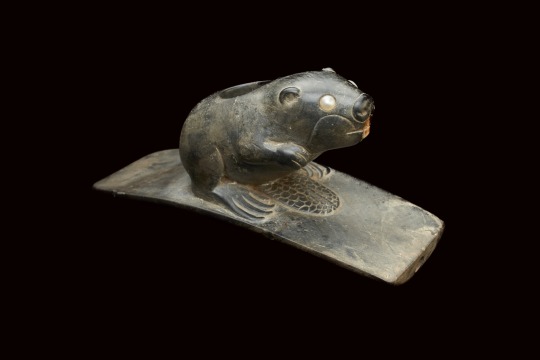

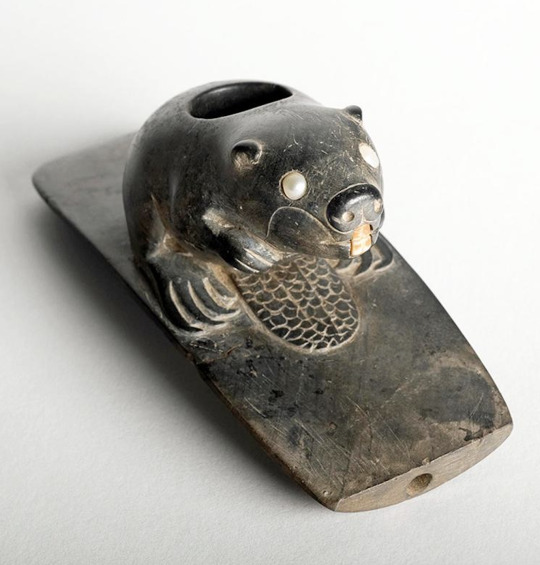
Beaver Effigy Pipe (circa A.D. 200-400)
Pipestone with mother of pearl and bone inlay. Hopewell Culture, from Tremper Mound in Scioto County, Ohio.
via. Gilcrease Museum, Tulsa
44 notes
·
View notes
Photo

Hopewell culture(s) and other similar cultures
106 notes
·
View notes
Photo
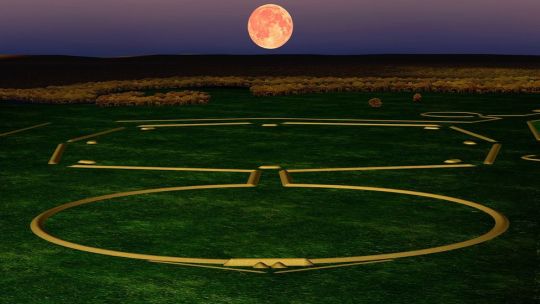
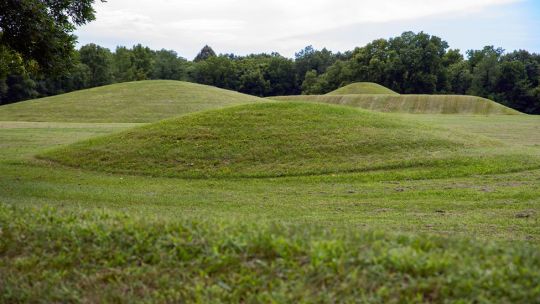
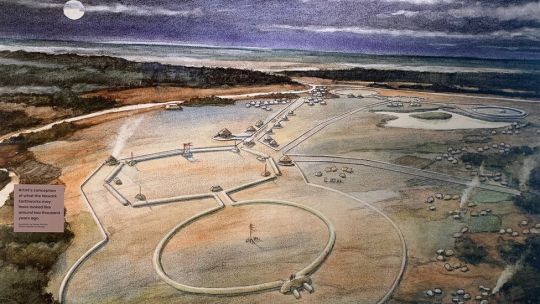
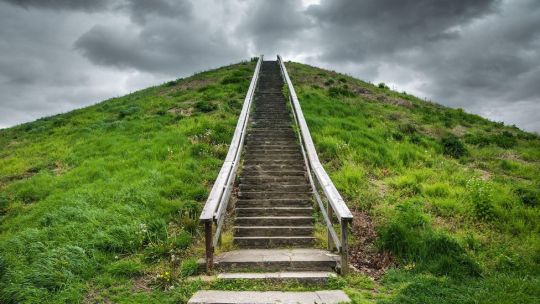
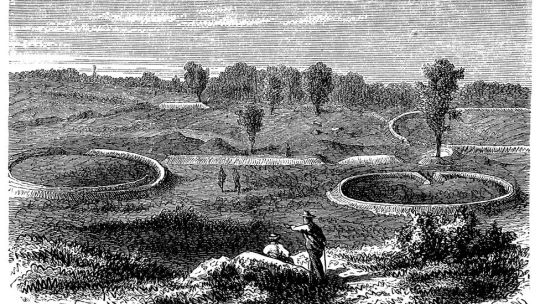



The US' 2,000-year-old mystery mounds - BBC Travel
Constructed by a mysterious civilisation that left no written records, the Hopewell Ceremonial Earthworks are a testament to indigenous sophistication.
Autumn leaves crackled under our shoes as dozens of eager tourists and I followed a guide along a grassy mound. We stopped when we reached the opening of a turf-topped circle, which was formed by another wall of mounded earth. We were at The Octagon, part of the Hopewell Ceremonial Earthworks, a large network of hand-constructed hills spread throughout central and southern Ohio that were built as many as 2,000 years ago. Indigenous people would come to The Octagon from hundreds of miles away, gathering regularly for shared rituals and worship.
"There was a sweat lodge or some kind of purification place there," said our guide Brad Lepper, the senior archaeologist for the Ohio History Connection's World Heritage Program (OHC), as he pointed to the circle. I looked inside to see a perfectly manicured lawn – a putting green. A tall flag marked a hole at its centre.
The Octagon is currently being used as a golf course. ...
... However, after the Hopewell Culture gradually began to disappear starting around 500 CE, other indigenous peoples stepped in to become caretakers of the land. One of those groups was the Shawnee Tribe, which called Ohio home before they were forcibly removed west of the Mississippi River in the 1830s.
"We may not have been responsible for building or creating them, but I know that my ancestors lived there, and that my ancestors protected them and respected them," said Chief Glenna Wallace of the Eastern Shawnee Tribe of Oklahoma, who believes that other tribes should have a role in the future of protecting the Hopewell Earthworks and communicating their cultural importance.
However, receiving Unesco status is a difficult, bureaucratic process. While sitting on land owned by the OHC, The Octagon is under the control of the Moundbuilders Country Club. The club negotiated an unprecedented lease that extends until 2078 and only allows visitors to walk the mounds four times a year. The rest of the time, visitors can access a platform in the car park to view a very small section of the property. OHC is currently suing to evict the country club (with compensation) through eminent domain. The lower courts ruled in favour of the historical society, but the Ohio Supreme Court is hearing an appeal. If OHC can't guarantee public access, this may affect Unesco's decision.
While a Unesco designation wouldn't entail the return of land or reparations, it does mean greater local representation and education about Ohio's Native American history. It also means more indigenous stakeholders, like the Shawnee, telling that story from an indigenous perspective for future generations.
"I just want people to know about it," said Chief Wallace, "I want people to be able to see it. I want people to be able to visit it and want people to realise that it is a cultural phenomenon. That it's priceless."
37 notes
·
View notes
Text

The Hopewell tradition, also called the Hopewell culture and Hopewellian exchange, describes a network of precontact Native American cultures that flourished in settlements along rivers in the northeastern and midwestern Eastern Woodlands from 100 BCE to 500 CE, in the Middle Woodland period. The Hopewell tradition was not a single culture or society but a widely dispersed set of populations connected by a common network of trade routes.[1]
1 note
·
View note
Text
Y’all I am So Excited about this. The Serpent Mound and the other Hopewell mounds are one of the few genuinely cool things about Ohio
Excerpts:
"In the past we might sometimes say 'Hopewell culture' or 'Hopewell people,' but what we really understand 'Hopewell' to be now is not a new peoples," explains Bill Kennedy, site manager and site archeologist at Fort Ancient Earthworks and Nature Preserve. "It's a new religious movement of people. It's happening all throughout eastern North America. It reaches a fluorescence, though, in southern Ohio that it doesn't reach anywhere else."
…Chief Ben Barnes of the Shawnee Tribe, who was involved in the earthworks nomination, also sees its inscription on the UNESCO World Heritage List as a step toward combating racist and ignorant stereotypes about his people and his ancestors.
"They're great civil engineers. They're artists, they're astronomers, mathematicians, and for my people, that's not the way that Shawnee people, or any Indigenous peoples in this country, are typically portrayed in media," he says.
In addition, the Hopewell Ceremonial Earthworks address gaps in the World Heritage List identified by the World Heritage Committee. Specifically, a lack of sites representing pre-contact Indigenous American sacred architecture and sites that represent early understandings of science, culture and astronomy.
…Today no federally recognized tribes remain in Ohio. They were all forcibly removed in the 17 and 1800s. Yet it was their ancestors who created these massive feats of design and engineering.
Glenna Wallace is chief of the Eastern Shawnee Tribe of Oklahoma and has been active in the World Heritage process. She says inscription on the World Heritage List is part of her mission to teach people about the earthworks that her ancestors built.
She says their inclusion would not be an ending, but another beginning.
"Our people may have been forced away from that place, and they may have disappeared, but what they built, what they constructed, what their values were, that's still there and that should be protected," she states.
"That's the reason for World Heritage."
In becoming a UNESCO World Heritage site, Wallace says she hopes the Hopewell Ceremonial Earthworks will finally attain the reverence and respect they deserve.
See the linked article for more details!
#indigenous culture#native american art#Native American archaeology#Indian mounds#Native American mounds#hopewell#unesco#Shawnee
64 notes
·
View notes
Text



Seip Earthworks - Hopewell Culture National Historical Park (2) (3) by Roam Your Home
35 notes
·
View notes
Text
not to be political but I've seen a lot of people saying that those who call Israel an apartheid don't know what they're talking about and um. As someone who has studied South African apartheid as well as grown up in a Jewish community. This claim has more merit than you think
#this post is brought to you by an article i read “debunking” the claim that israel is an apartheid and their “evidence”#included several policies that are the same if not more intense than apartheid era policies against black south africans#there are comparisons that hold weight here#although one thing i dont get and havent had explained to me yet. it looks to me as though both arabs and jews are indigenous to the region#in the way that both the hopewell culture and lenape people are indigenous to my state of pennsylvania#and thats a flimsy comparison i suppose since the hopewell culture (who lived here first chronologically) has died out#but anyway theres a case for indigeneity for both jews and arabs#its so silly to me that we dont consider both to be indigenous? yes many jews that came into israel in the early 20th century were#white europeans and carried the colonial baggage of that with them#but idk why its so hard to believe that an oppressed group can also be an oppressor?? like where's the intersectionality babes#anyway. the original point of this post was that maybe more of yall need to look into what south african apartheid was actually like#much like h*m*s leadership a lot of the ANC leadership was forced into exile and had to live and work outside of their country#(and this comparison is not perfect im aware. the tactics of the anc and h*m*s are totally different. however i think this comparison has#weight in that they are both one of the biggest names in opposition to the government. they do this in different ways at different levels o#intensity and violence. that is not to be ignored. but there are some comparisons that we can make and exile doesnt strike me as a bad one)#the bantustans in south africa were also constructed in a way that much like the west bank makes it highly difficult for an actual real#state to form#and the way that theyre set up invites puppet governments and corruption. this gives a major advantage to the apartheid state#id recommend reading Trevor Noah's Born A Crime if you havent#its a great introduction to what daily life in aparthid and after was like (its a memoir from about 1990-2005ish)#(apartheid was legally ended in 1994 but there are still remnants of it today and there were even more at the time of Born a Crime)#anyway these are my political thoughts of the day#edit: to my tangent about both groups being able to have some sort of claim to indigeneity. that in no way justifies any of the brutality#going on#i think its espeically cringe of israel to claim indigeneity and a sacred relationship with the land then create an environmental#catastrophe like they have in gaza. making the land unliveable is a bit of a perversion of the relationship you have with that land innit#in case it wasnt clear: ceasefire now and free palestine
9 notes
·
View notes
Text
0 notes
Text
"They're great civil engineers. They're artists, they're astronomers, mathematicians, and for my people, that's not the way that Shawnee people, or any Indigenous peoples in this country, are typically portrayed in media." Chief Ben Barnes of the Shawnee Tribe
Tana Weingartner for NPR: "Ohio's Hopewell Ceremonial Earthworks are about to be a UNESCO World Heritage Site"
"Of just over a thousand [Heritage] sites worldwide deemed of universal importance and value to humankind, there are only 24 in the United States that carry that distinction."

Outside the Great Circle at Newark (with visitor for scale, to the left in the distance). The Circle’s earthen berm stands anywhere from around 6 feet, to 14 feet high. Jake Wood
"Now, after more than a decade of work and planning, ancient earthworks in Ohio are poised to join them...
The Hopewell Ceremonial Earthworks encompass eight sites — a collection of historic earthen mounds built by Indigenous peoples:
Fort Ancient Earthworks and Nature Preserve
Hopewell Culture National Historical Park (five geographically separate elements)
Mound City Group
Hopewell Mound Group
Seip Earthworks
High Bank Earthworks
Hopeton Earthworks
Newark Earthworks
All the sites were built 1,600 to 2,000 years ago by peoples formerly referred to as Hopewell...
It might be unusual to consider huge mounds of dirt as anything significant, however, UNESCO calls the earthworks a 'masterpiece of human creative genius.' That's one of the criteria for inclusion on the World Heritage List. Another calls for bearing "exceptional testimony to a cultural tradition or to a civilization which is living or which has disappeared."
The design and construction of the Earthworks show the people during this early era had a clear understanding of geometry, architecture, and solar and lunar alignments and multi-year cycles."
Full story with audio from Weekend Edition Saturday.
In my various travels, I've visited some of these; more information on some of those astronomical alignments is on available on Jake Rambles n'at, including diagrams on satellite views ('cause I do that):

1 note
·
View note
Note
Hi. I study archeology and I love stuff that looks like animals and people need to know about Hopewell culture effigy platform pipes.
They are so beautifuly made and cute. I love those lil guys.
Look at this beaver:

The craftsmanship!!!
And this otter:

Those lil paws! ☺️
There's way more but these lil guys are my favorite.
Please include them in some future post.
🥰
125 notes
·
View notes
Text

Nicholls Mound near the city of Trempealeau on the Mississippi River is an example of a Hopewell site in Wisconsin. When archaeologists from the Milwaukee Public Museum excavated the mound in the late 1920 - 1930's they discovered a burial tomb dug into the ground and covered with logs. A 12 foot high mound was built over the tomb. The tomb contained several individuals who were buried with ceremonial items made from exotic materials. Some of the items included large stone knives over 6 inches long made of obsidian from the Rocky Mountains, copper earspools, 6 copper axes, marine shell beads, and 20 freshwater pearl beads. You can still visit Nicholls mound from the Great River State Bike Trail just east of Trempealeau. Learn more about Nicholls Mound at: https://www.uwlax.edu/mvac/past-cultures/specific-sites/trempealeau/#Nicholls. Pictured: A recent picture of Nicholls Mound.
19 notes
·
View notes
Text

The Ohio Hanukkiah Mound was a mound believed to be in the shape of a menorah and oil lamp, located near the Little Miami River in Milford, Ohio. Its origins are typically attributed to the Hopewell culture.
12 notes
·
View notes
Text
I have been obsessed with Fort Meigs recently and the Ohio campaigns of the War of 1812, so this news article hit differently. The Ohio History Connection (the same organisation behind the Fort Meigs historic site) is trying to preserve a historic and culturally significant Indigenous earthworks from the golf course that has used it since 1910. The fact that this callous use of an ancient astronomy and ritual calendar site has been allowed to go on also reflects the violent removal of the Shawnee people who by all rights should have been there protecting and using the site. Imagine if they made Stonehenge a golf course!
This is all related to the War of 1812 and campaigns against the Shawnee, Potawatomi and Miami Nations. I have been thinking a lot about this since Indigenous Peoples' Day is Monday, and I have been thinking of writing up something with a predictable War of 1812 focus (there is a lot of material). It just goes to show how much the issues of the War of 1812 continue to affect the present day.
#war of 1812#indigenous#shawnee#ohio#us history#hopewell ceremonial earthworks#world heritage site#settler colonialism
45 notes
·
View notes
Text

most of these are people's usernames, i think the first non-username is "jd" and "tallahasssee" which is very appropriate. note nonpermanent, nondestructive, hopewell (the native culture), tinder, euphoriant, mesosphere, kokomo, aztec, geodesic, inhaltant, perineal, spiro, bummer
also

ive never say sorry, love, or twitter
6 notes
·
View notes
Note
Dude dude dude. Wdym you know lots about Cornish history. Please share. I want this info dump. I want to know more. I will beg on my knees if necessary.
!!!!
I guess it depends on which period of Cornish history you wanna know about! I admit I don’t know a great deal about say Dunmonia or the really properly ancient culture in Cornwall. I take more of an interest in the social and industrial side of Cornish history. But I can give you a run-down of some parts of Cornish history you’ll never shut me up about!
The Cornish Jacobites and their rebellion in 1715! It actually had an impact on the 1745 rebellion, as well, as one of the Cornish Jacobite leaders’ (who was tossed in Newgate prison) family were suspected of harbouring Prince Charles Stuart, though it’s unlikely this did in fact occur. Actually this whole period is really interesting!
Cornwall during the French Rev wars!! So actually. In Cornwall, the ideas of Liberté, égalité, fraternité we’re quite popular. So popular in that in St. Just which was on the Tin Coast, a group of men planted a Liberty Tree. There was also a great deal of economic struggle (Cornwall has always been one of the poorest regions in the UK, however it was particularly drastic at this time, so much so that if you were a working family, you’d likely not be able to afford wheat for bread as it was extraordinarily highly priced). In fact, the officials of the area feared an uprising. I don’t have the number off the top of my head, but the reason they feared an uprising in Cornwall so much was because they’d be extremely outnumbered. Like I said, don’t have the precise number but it would’ve been a blood bath. Though luckily enough, the wars would very soon come to an end. Until the Napoleonic Wars kicked off.
Cornwall during the Napoleonic Wars is just. I could write a book or a very, very long essay. It’s also a very important time for industry. However Cornwall also held a unique position, being so close to France. French refugees trying to flee the war would be snuck across the channel and into Cornwall. They would also be given English names and set up with work. Not official, by the way. This wasn’t exactly a government approved activity. However there were also a few prisoner of war camps in Cornwall, a notable one in Roskrow. Detectorists must have a blast there… I’m also extremely emotional about one Captain James Quick, a St. Ives merchant captain who was taken a prisoner of war after setting sail from Falmouth and his ship, the Hopewell, becoming extremely damaged, losing all sails and being driven to the French coast and grounded in November 1810. He married his wife in just September. I actually have read the letters he wrote to his wife Harriett during this time and Christ. It’s a hell of a thing. He eventually made it home in 1814.
Industry in Cornwall is something I’ve touched on already a bit. But mining, fishing and farming were the biggest. And there’s the technology developed for it. One day I’ll need to talk in depth about the submarine mines, specifically Levant Mine (though it is a truly horrific story). Levant was actually 600 meters deep and before the “man engine” men and boys would have to climb around 80 sets of ladders up and down every single day, twice a day, in extremely hot mines that, at their longest stretched a mile beneath the sea floor. It wasn’t uncommon for men to just pass out from exhaustion on the ladders. A beam engine was introduced, which is still there. The only one in Cornwall.
By WWI, Cornwall has been pretty well established as a major entryway for trade into and out of the UK. Falmouth was THE port of call for ages. However, there was something called spy mania. Officials were worried German spies may use Cornwall to get into the country. This led to mass incarcerations of “spies” (many of whom were proven innocent) and subsequent executions. However even if you weren’t a spy, people coming into the country could be detained, thrown into a jail/workhouse and then drafted against their will into the war. It would have been a horrifying time to try and come into the country. On the topic of world wars and Cornwall, there are some places — one, I actually believe around Falmouth — where coastal defences managed to sink German uboats and at low tide you can even walk out to them (or at least they become exposed enough you can clearly make them out).
Once the tin and copper dried up, many Cornish miners were told they could have free land in places like Australia (and if this sounds a bit like what the US government told labourers in the mid 19thc, well it’s a theme). Besides Australia, many MANY miners also went to North America. In Mexico there’s even a town called Real de Monte, sometimes called “Little Cornwall” for its Cornish heritage there. Some Cornish miners also went as far West into America as California — again, which has a number of Cornish names about — and into the Appalachians and all along the east coast. The Hoosac Tunnel Disaster in 1853 was heavily being worked by Cornish immigrants and took over 20 years to complete.
I’ve not even touched on the language and the rebuilding thereof, nor cultural history or festivals. Or the smuggling!!! Or the civil war!!! Or it’s number of rebellions!! As I say, it really depends on which era and what aspect of Cornish history you’d be interested in learning about! I just kinda did a quick play by play, highlights! I highly recommend going to Kresen Kernow’s website (archives in Redruth) as well as the Royal Cornwall Museum which has quite a few digitised records in their online archives. Bodmin War Museum and the Falmouth Maritime Museum are also very useful! And if you ever go to Cornwall, PLEASE go to the local museum! You won’t believe the kind of things the volunteers will tell you or the absolute wild history of some of the objects. I can also recommend some reading, too.
#please don’t beg on your knees#I will happily always talk Cornish history#I’m just shy lol#anyways YEA!! there’s A LOT of history here and while I have my own specific areas of interest I did want to cast a wide net lol#pls feel free to ask me about anything here#gonna get sad thinking about James Quick brb#thanks for the ask!!!!!#<33333
7 notes
·
View notes
Text

August Wildflowers and Grasses by Christa Binder
Via Flickr:
Seip Earthworks - Hopewell Culture National Historic Park. Ross County, Ohio
#hopewell culture national historical park#chillicothe ohio#ross county#they built mounds#death of summer
14 notes
·
View notes